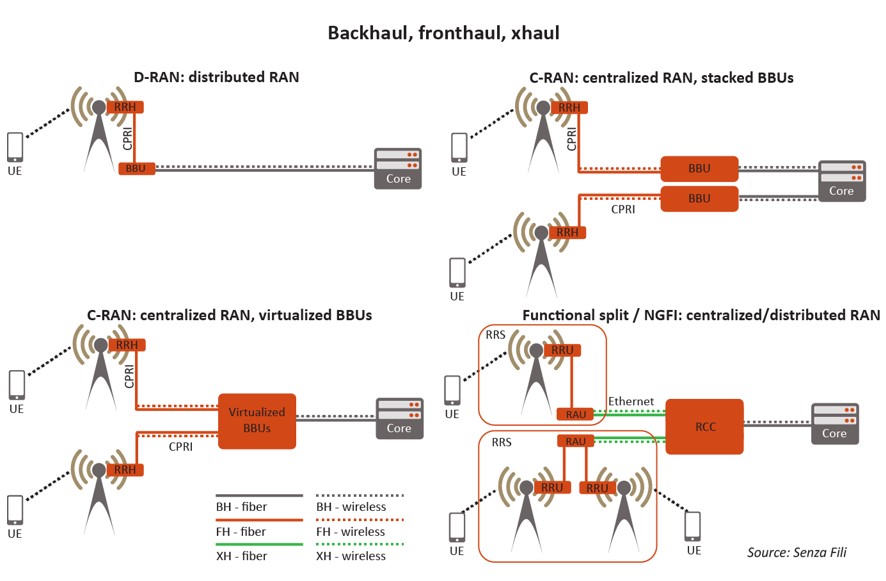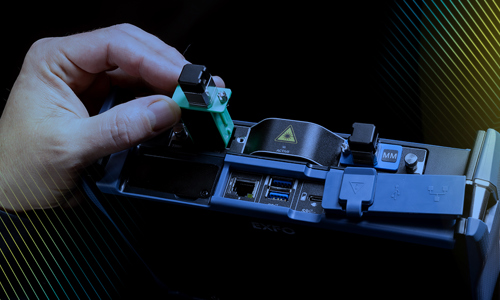Improving latency and capacity in transport for C-RAN and 5G. The evolution of transport, from backhaul, to fronthaul, to xhaul.
Wireless networks continue to change at a fast pace. We use them more, and in new and more pervasive ways. With IoT, a bewildering set of new devices will reduce the dominance of the mobile phone as the primary access device.
The evolution of mobile networks enables this change by accommodating the higher traffic loads and more demanding services. As a sort of glue that binds the different parts of wireless networks together, transport is also evolving, to keep up with the new capabilities in the RAN and the core of wireless networks.
More is required of backhaul and fronthaul, though, to prevent transport from becoming a bottleneck that limits the capacity and performance gains in the RAN and the core. Densification, C-RAN, 5G and the availability of mmW spectrum bands set a higher bar for transport in terms of capacity, latency, reliability and security. At the same time, the higher demands on transport have to be balanced by the need to keep costs under control. Backhaul and fronthaul have to adapt in a cost-effective way: transport costs cannot grow linearly with the increase in user-plane capacity. Solutions are emerging that give mobile operators enough flexibility to manage the tradeoffs among cost, performance and resource availability.
But it not just a tightening of requirements that we are seeing. The increasing complexity of both wireless networks and the traffic they carry creates a need to test, manage and monitor backhaul and fronthaul traffic. Mobile operators have to manage an increasing diversity of RAN elements in multi-layer networks with varied topologies, which in turn use multiple backhaul and fronthaul solutions. The need to closely coordinate transmission in these dense deployments has increased the prominence of backhaul and fronthaul, and it creates unprecedented requirements in terms of latency, timing and synchronization.
In my latest report, I look first at the drivers of change that are shaping the direction in which transport is evolving. In the second half of the report, we look at the trends that will make it possible for backhaul, fronthaul and, in time, x-haul – which we will refer to as backhaul, fronthaul and XH, respectively – to optimize resource utilization in end-to-end mobile networks today and in the future.
The increase in microwave and mmW spectrum availability unleashes huge amounts of capacity in bands that have so far been underused. This opens the way for new wireless transport options – namely fronthaul and self-backhaul – and for a new breed of fixed wireless access. It also removes the dichotomy of wireline and wireless transport (and access), allowing them to closely coexist in a pervasive network infrastructure that serves an access environment increasingly dominated by wireless devices, even in use contexts where there is no mobility.

Key report findings
Transport is evolving. Backhaul still dominates transport from the cell site. But with C-RAN and virtualization, baseband processing in the BBU is moving away from the cell site, creating demand for fronthaul and xhaul between RRHs and remote BBUs in C-RAN aggregation points.
5G sets out strict requirements for transport in terms of capacity, latency, and reliability. Transport interfaces and management have to evolve to meet 5G performance needs in a cost-effective way.
Densification increases the number of sites to be connected, and their variety. MNOs need multiple transport solutions to address the increased complexity in the RAN.
Demand for fronthaul will continue to rise. But fronthaul has to become more flexible, efficient, and affordable, or it could become a bottleneck that slows down C-RAN adoption. An important step in this direction is a move toward Ethernet-based fronthaul.
The emerging consensus is that we need to move beyond today’s CPRI. This may entail a new fronthaul interface or an evolved CPRI that reduces current CPRI bandwidth requirements and that works over Ethernet transport.
Functional splits enable MNOs to choose the best combination of centralized RAN and distributed RAN, while avoiding the heavy bandwidth requirements of fronthaul and moving to XH, a new type of transport that includes both backhaul and fronthaul as the border cases and can accommodate any functional split.
MmW spectrum, especially the V-band and E-band, expands solutions and capacity for wireless fronthaul and backhaul, easing the business case for C-RAN topologies in multi-layer networks with small cells and for locations where fiber is not available.
With the increasing diversity of fronthaul and xhaul solutions, there is a need to manage complex backhaul/fronthaul/ xhaul networks in real time, coordinating different transport technologies, interfaces, performance, and RAN requirements while retaining the benefits of coordinated transmission. Through initiatives such as NGFI, MNOs and vendors are working toward a standards-based platform to manage fronthaul and xhaul in multi-vendor environments.
Testing and monitoring of backhaul/fronthaul/ xhaul becomes more complex, but also gains prominence to ensure transport does not become a bottleneck and that its performance is optimized to get the best QoE the network can support.
Fixed wireless using mmW spectrum has become a hot technology within 5G. It can bring broadband connectivity to households and small businesses as an extension of fiber networks. At the same time, mmW can be also used for access and backhaul/fronthaul/ xhaul, creating an opportunity for the growth of a strong ecosystem and set of services making use of spectrum assets that have been sparsely used to date.
Transport is evolving. backhaul still dominates transport from the cell site. But with C-RAN and virtualization, baseband processing in the BBU is moving away from the cell site, creating demand for fronthaul and xhaul between RRHs and remote BBUs in C-RAN aggregation points.
Testing and validating fronthaul links
The report includes an in-depth interview with Marquis Dorais, Fronthaul Product Line Manager, T&D Metro / Access Business Unit, at EXFO. We talked about how the need for fronthaul keeps growing as operators move to C-RAN topologies. Along with the widening deployment of fronthaul, there is a need to test and validate fronthaul links.
The demand for fronthaul to remote locations increasing with C-RAN deployments today and 5G in the future. “Today, CPRI rates are designed to support up to 24.3 Gbps of RF data capacity, not on the IP side but on the CPRI side. … There is going to be a need for faster fronthaul and backhaul speeds. On the fronthaul itself, today it’s mostly going up to 10 Gbps. With the eventual move toward 5G, the fronthaul will move to 25 Gbps, 50 Gbps, even 100 Gbps, so extremely fast protocol data rates running on the fronthaul portion,” Marquis said.
The increasing capacity and latency requirements will trigger a new approach to fronthaul. Marquis told us, “We know that eventually the RAN equipment will adopt a communication protocol that’s a lot more flexible in transporting the information to the RRH. Eventually, we foresee an evolution towards Ethernet fronthaul. At EXFO we are well positioned to address new and emerging technologies – having been at the forefront of Ethernet testing – and we will be there to support our customers and deliver Ethernet-based fronthaul testing solutions.”
Watch the full interview with Marquis Dorais: https://youtu.be/8VWbYKfcIzM




